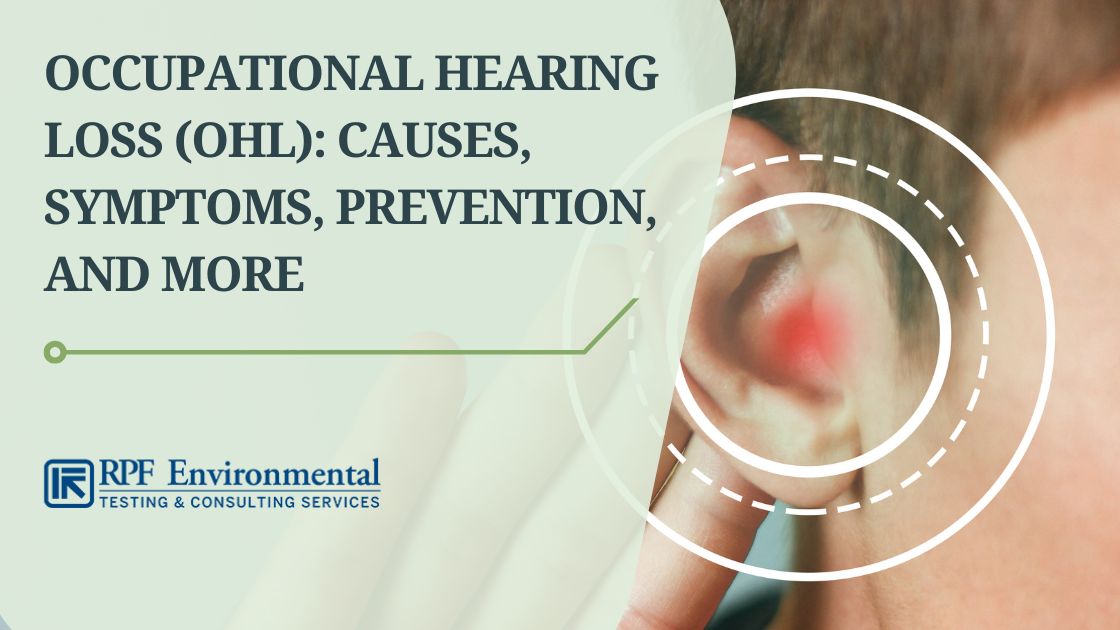Occupational hearing loss can be caused by exposure to loud noise or ototoxic chemicals during work. It usually occurs slowly and worsens over time. Once the inner ear is damaged, it can lead to permanent hearing loss that can’t be treated with medicine or surgery.
But, employers can help prevent exposure to hazardous noise in the workplace to avoid permanent hearing loss in workers. We will discuss prevention strategies here including the causes and symptoms of OHL among other important things you need to know.

RPF Environmental offers various environmental health and safety training services in Illinois, Indiana, Maine, New Hampshire, Massachusetts, and across the the country. Our training courses include job safety analysis, PPE requirements, hazardous energy control, and others. Contact us now!
Causes of Occupational Hearing Loss
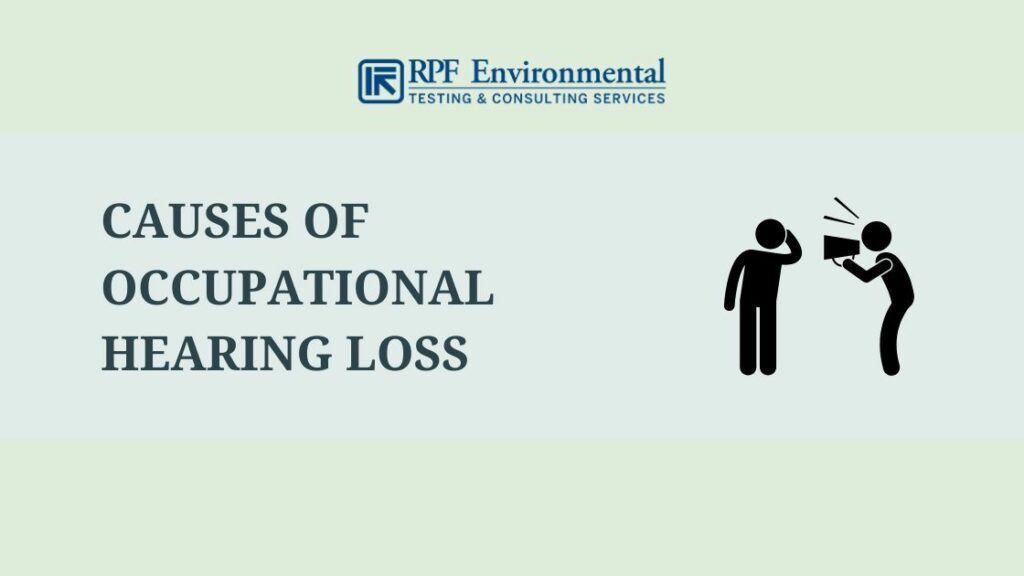
Work-related hearing loss commonly occurs in the manufacturing, construction, and mining industries. The degree of hearing loss will vary based on:
- The loudness of the sound
- The amount of exposure to ototoxic chemicals
- The potency or strength of the ototoxic chemical
- The frequency of the exposure
- The length of the exposure
1. Exposure to Hazardous Noise
Noise-induced hearing loss (NIHL) can be caused by extended exposure to loud sounds or a one-time exposure to very loud sounds, impulses, or blasts. Aside from hearing loss, exposure to hazardous noise can also cause tinnitus which is described as a ringing, buzzing, or roaring noise in one or both ears.
What Volume of Sound Can Damage Your Hearing?
According to the Centers for Disease Control and Prevention (CDC), noise is considered hazardous if it is 85 A-weighted decibels (dBA) or higher. In fact, the Recommended Exposure Limit (REL) by the National Institute for Occupational Safety and Health (NIOSH) is 85 dBA averaged over an 8-hour workday. If you are exposed to noise equal to or above 85 dBA, you are more likely to develop severe hearing loss over time.
For reference, normal conversations have an average decibel rating of 60-70 dBA. Also, below are some examples of equipment based on the average noise levels they produce:
- 85-90 dBA: Vacuums, printing presses, power tools
- >= 95 dBA: Ambulance sirens, bulldozers, chainsaws, nightclubs
Know More Here: Acceptable Noise Level: At What Decibel Is Hearing Protection Required?
How Does Noise-Induced Hearing Loss Actually Occur?
Loud noise can damage parts of your ear like nerves, hair cells, and membranes which can lead to temporary or permanent hearing loss. But, the damage will become permanent with long-term exposure to loud noise due to more nerve endings dying.
Determining Whether an Employee Is Exposed to Excessive Noise
You can use the free Sound Level Meter App of NIOSH for iOS mobile devices to measure sound levels in the workplace. It can help determine whether your workers may be exposed to hazardous noise and can also guide you in creating effective plans for preventing occupational hearing loss.
2. Exposure to Ototoxic Chemicals
Chemically-induced hearing loss (CIHL) is caused by exposure to specific chemicals called ototoxic chemicals or ototoxicants. These are chemicals that can cause damage to the ears especially the inner ear (cochlea) and/or auditory neurological pathways as well as cause tinnitus. Aside from the factors we mentioned earlier, age, smoking status, and exposure to hazardous noise can influence the extent of damage caused by ototoxicants to the ears.
Exposure can happen via ingestion, inhalation, or skin absorption. Once exposed, the ototoxicants can travel through your bloodstream and damage your inner ear.
Some Examples of Ototoxic Chemicals
- Solvents
- Metals
- Compounds (e.g. lead and mercury compounds)
- Asphyxiants (e.g. tobacco smoke, carbon monoxide)
- Nitriles
- Pharmaceuticals
Industries That May Be Using Ototoxicants
- Manufacturing (e.g. petroleum, paper, machinery, leather, textile, etc.)
- Mining
- Construction
- Utilities
- Agriculture
In addition, occupational activities like pesticide spraying, painting, and printing that may involve both hazardous noise and ototoxicant exposure can lead to more severe hearing loss.
Symptoms/Signs of Work-Related Hearing Loss
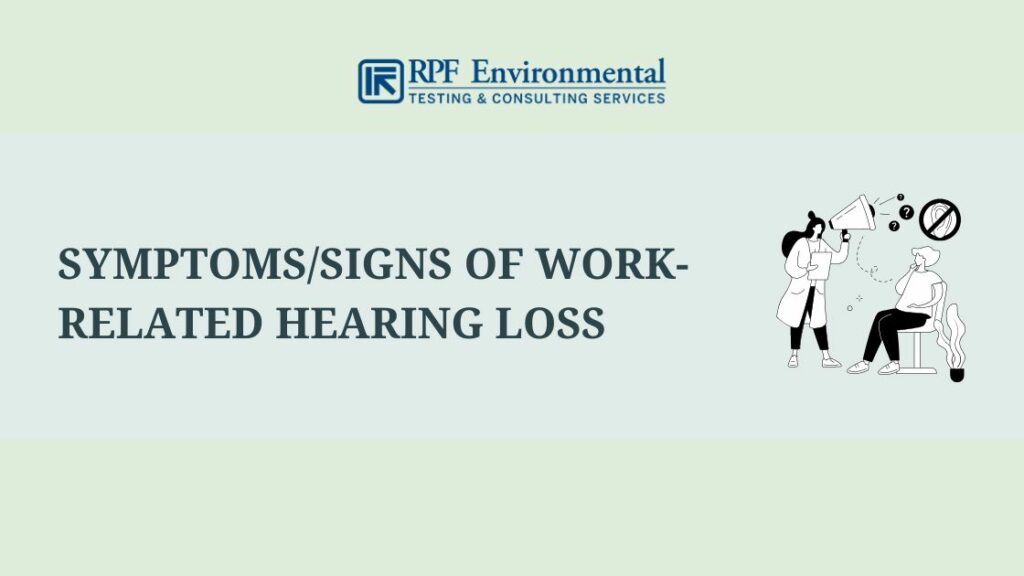
Work-related hearing loss, whether it is noise or chemical-induced, can be temporary or permanent depending on various factors. It can also affect both or only one ear. Common signs may include the following:
- Buzzing or ringing in the ears (tinnitus) that often accompany hearing loss
- Mumbling, muffled or distorted sounds
- The need to shout even if your coworkers are nearby
- Difficulty hearing with the presence of background noise
- Speech discrimination dysfunction (inability to distinguish sound from ambient noise)
Treatment: Can Occupational Hearing Loss Be Treated?
There are cases where hearing loss is temporary. But, it can become permanent once the inner ear, including the nerve endings, becomes too damaged to repair and medicine or surgery can’t correct it.
The only “treatment” you can do is to prevent further damage to your ears by protecting them from loud noises. Developing coping skills like lip reading is also another way. You can use hearing aids and other devices to help you, but they won’t be able to restore your hearing to normal. For severe cases, a cochlear implant might be necessary.
In addition, a few hearing tests that may be done include the following:
- Physical exams
- Speech and word recognition tests
- Tuning fork tests
- Pure-tone tests
- Acoustic Reflex Measures
- Tympanometry test
NOTE: Workers exposed to ototoxic chemicals or hazardous noise are recommended to have an annual hearing test.
Prevention: How to Prevent Occupational/Industrial Hearing Loss
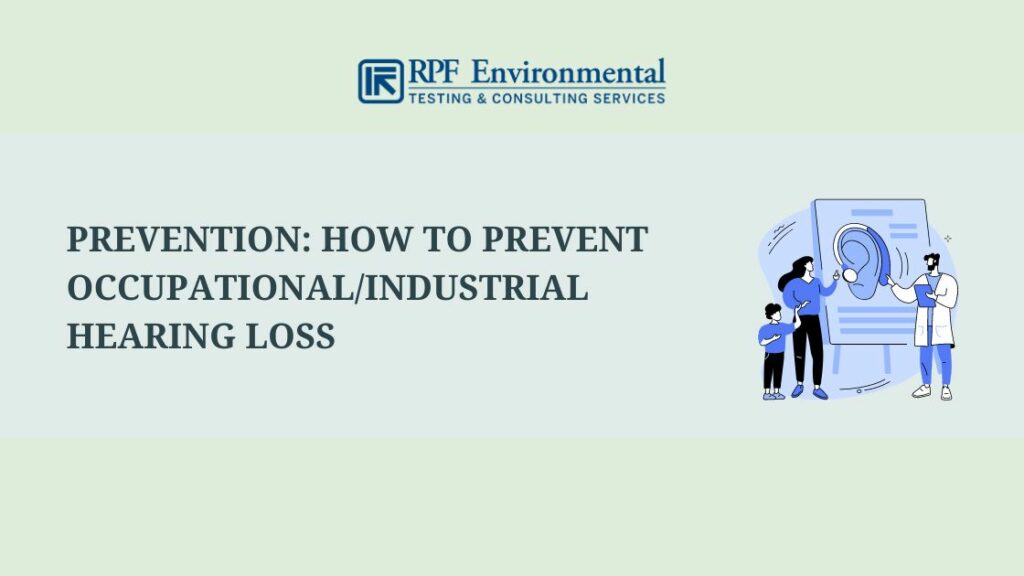
Employers play a big role in preventing hearing loss in the workplace. They are responsible for providing their workers with a safe environment as well as proper training to avoid exposure to hazardous noise.
NIOSH’s Hierarchy of Controls can be used to remove or reduce workplace hazards including hazardous noise. It consists of five levels of prevention strategies with the top level being the most effective one. You can also combine multiple strategies to maximize worker protection.
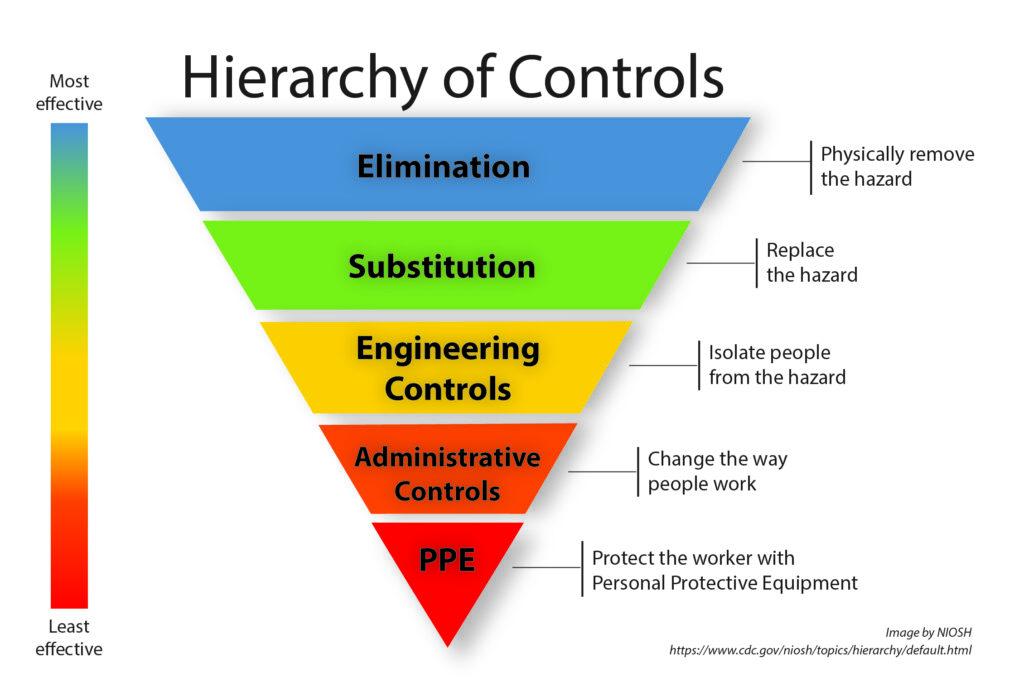
Source: CDC
Below are examples of actions under each level:
Level 1. Elimination
- Completely remove the source of the hazardous noise to eliminate exposure
Level 2. Substitution
- Use quieter tools/equipment
- Replace ototoxic chemicals with less toxic ones
You can also use Prevention through Design strategies for substitution and elimination where you include prevention considerations when designing work processes, operations, tools, equipment, and products.
Level 3. Engineering Controls
When substitution or elimination is not possible, engineering controls are used which include making changes to the workspace or equipment:
- Placing a barrier between the workers and the source of the noise
- Enclosing the source of the noise to isolate it
- Isolating workers from the source
Level 4. Administrative Controls
- Reduce the intensity, duration, or frequency of exposure through job rotation, rest breaks in quiet areas, and others
Level 5. Personal Protective Equipment (PPE)
- Employers should train workers on how to use PPE properly, especially when working with ototoxic chemicals
- Workers should use Hearing Protection Devices (HPDs)
You can also read NOISH’s Criteria for a Recommended Standard for Occupational Noise Exposure.
Other Things You Need to Know About Occupational Hearing Loss
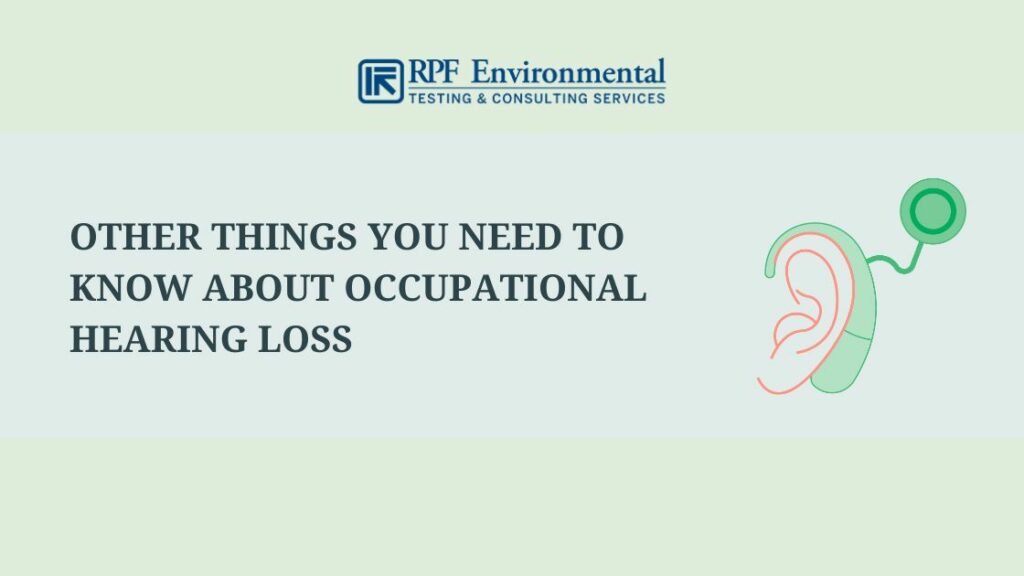
Occupational Hearing Loss Statistics
Below are hearing loss statistics in the United States from CDC:
- 30 million workers who are dealing with chemicals are exposed to some ototoxic chemicals
- 22 million workers are exposed to hazardous noise in the workplace each year
- 53% of exposed workers do not wear hearing protection
- Around 12% of workers have difficulty in hearing
- 13% of exposed workers are hearing-impaired in both ears
You can also find hearing loss statistics by industry here.
Health & Safety Impacts of Occupational Hearing Loss
Exposure to hazardous noise can impact the health of the workers and safety in the workplace:
Health Impacts
- Long-term exposure to loud noise can cause permanent hearing loss or tinnitus
- Psychological and physical stress
- Poor mental health (anxiety and depression)
- Reduced productivity
- Impaired ability to communicate
- Poor concentration abilities
- Research has shown that hearing loss is linked to heart problems and cognitive decline
- Pregnant women exposed to hazardous noise can impact the developing baby’s health
Safety Impacts
- Hearing loss causes difficulty in hearing warning signals which can lead to workplace injuries and accidents
Occupational Noise Exposure Standards
As per OSHA, employers are required to implement hearing conservation programs when the noise in the workplace is at 85 dBA (averaged over 8 work hours) or above. In addition, employers should provide employees with a workplace that is free from hazards, including hazardous noise, that can cause serious physical harm. You can find more about OSHA’s occupational noise exposure standards here.
Also Read:
- Hazardous Waste Operations & Emergency Response: What is HAZWOPER?
- Lockout vs Tagout: Difference Between Lockout and Tagout
- E-Stop Lockout Devices: Can You Use Them in Lockout Procedures?
- Everything You Need to Know About Confined Spaces
FAQs
Examples of jobs that are likely to cause hearing loss are those involving machinery like in the construction, farming, manufacturing, and mining industries. Military jobs involving aircraft noise and combat are other examples.
Occupational hearing loss can be caused by exposure to loud noise or chemicals that can cause damage to the ears (ototoxic chemicals). Short-term exposure may only cause temporary changes in your hearing or tinnitus. But, long-term and repeated exposure can lead to permanent hearing loss that can’t be treated through surgery or medicine.
The 4 P’s of occupational noise-induced hearing loss are:
1. It is Painless.
2. It is Progressive.
3. It is Permanent.
4. Almost Preventable.
Noise-induced hearing loss (NIHL) is the most common cause of workplace hearing loss. In fact, 22 million American employees are exposed to hazardous noise each year.
Conclusion
Occupational hearing loss is often permanent. No surgery or medicine can treat it once vital parts of your ear have been damaged. Though it is permanent, you can prevent it through NIOSH’s Hierarchy of Controls. Creating a safe workplace for employees is the first step in preventing work-related hearing loss.
Reach out to us to know more about RPF Environmental’s EH&S training services to ensure the safety of your employees in the workplace. We serve businesses and organizations in different industries nationwide.

